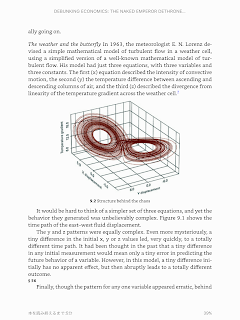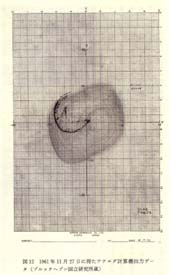2nd Edition 2012, Kindle版
CONTENTS
Tables, figures and boxes
Where are the diagrams?
Preface to the second edition
Preface to the first edition
1 Predicting the ‘unpredictable’
2 No more Mr Nice Guy
Part 1 Foundations: the logical flaws in the key concepts of conventional economics
3 The calculus of hedonism
4 Size does matter
5 The price of everything and the value of nothing
6 To each according to his contribution
Part 2 Complexities: issues omitted from standard courses that should be part of an education in economics
7 The holy war over capital
8 There is madness in their method
9 Let’s do the Time Warp again
10 Why they didn’t see it coming
11 The price is not right
12 Misunderstanding the Great Depression and the Great Recession
Part 3 Alternatives: different ways to think about economics
13 Why I did see ‘It’ coming
14 A monetary model of capitalism
15 Why stock markets crash
16 Don’t shoot me, I’m only the piano
17 Nothing to lose but their minds
18 There are alternatives Bibliography
Index
内容
テーブル、図、箱
図はどこにありますか。
第2版のはじめに
初版のはじめに
1「予測不可能」を予測する
2これ以上氏ナイスガイ
パート1基礎:従来型経済学の重要概念における論理的欠陥
3快楽主義の計算
4サイズは関係ありません5すべての価格と価値なし
6それぞれに彼の貢献に従って
パート2複雑さ:経済学の教育の一部であるべき標準的なコースから省略された問題
7資本に対する聖戦
8彼らの方法には狂気がある
9もう一度タイムワープをやりましょう
10なぜ彼らはそれが来るのを見なかったのか
11価格が正しくありません
12大恐慌と大後退の誤解
第3部代替案:経済学について考えるさまざまな方法
13それがやってくるのを見たのはなぜですか
14資本主義の貨幣モデル
15株式市場が暴落する理由
16私を撃ってはいけない、私はピアノだけだ
17失うものは何もない
18他にも選択肢があります
索引
2ed序文:
Debunking Economics was far from the first book to argue that neoclassical economics was fundamentally unsound. If cogent criticism alone could have brought this pseudo-science down, it would have fallen as long ago as 1898, when Thorstein Veblen penned ‘Why is economics not an evolutionary science?’ (Veblen 1898). Yet in 1999, when I began writing Debunking Economics, neoclassical economics was more dominant than it had ever been.
2001年に初版
第2版は金融危機を予言した12人のリストが引用、紹介されている
NOTES
Chapter 4
1 In fact, the advanced courses also ignore these more difficult critiques, which means that students who do them, if anything, are even more ignorant than undergraduates.
2 This last paper –‘Debunking the theory of the firm –a chronology’ –is freely downloadable from www.paecon.net/ PAEReview/ issue53/ KeenStandish53. pdf.
http://www.paecon.net/PAEReview/issue53/KeenStandish53.pdf
^
Milton Friedman (1953). “The Methodology of Positive Economics”, in Essays in Positive Economics, University of Chicago Press, Chicago: 3-43.
Steve Keen (1993a). “The misinterpretation of Marx's theory of value”, Journal of the History of Economic Thought, 15 (2), Fall, 282-300. Steve Keen (1993b). “Use-value, exchange-value, and the demise of Marx’s labor theory of value”, Journal of the History of Economic Thought, 15 (1), Spring, 107-121. Steve Keen (2001). Debunking Economics, Pluto Press & Zed Books, Sydney & London.
(2004a). “Why economics must abandon its theory of the firm”, in Salzano, M., & Kirman, A. (eds.), Economics: Complex Windows, Springer, New York, pp. 65-88.
(2004b). “Deregulator: Judgment Day for Microeconomics”, Utilities Policy, 12: 109 –125.
(2004c). “Improbable, Incorrect or Impossible: The persuasive but flawed mathematics of microeconomics”, in Fullbrook, E. (ed.), Student's Guide to What's Wrong with Economics, Routledge, London, pp. 209-222. Steve Keen and Russell Standish (2005). “Irrationality in the neoclassical definition of rationality”, American Journal of Applied Sciences (Sp.Issue): 61-68. Steve Keen and Russell Standish (2006). “Profit Maximization, Industry Structure, and Competition: A critique of neoclassical theory”, Physica A 370: 81-85.
Piero Sraffa (1930). “Increasing Returns And The Representative Firm A Symposium”, Economic Journal 40 pp.79-116.
George J. Stigler (1957), Perfect competition, historically contemplated. Journal of Political Economy 65: 1-17.
付録46頁分
http://www.debtdeflation.com/blogs/wp-content/uploads/books/Keen_supplement.pdf
労働者、資本家、銀行家の所得シェア
(大平穏→格差拡大)
2016年10月29日
形式: ペーパーバックAmazonで購入
2008年の金融危機以降、経済学界は大騒ぎになり、騒ぎの中でオランダの経済学者Dirk Bezemer氏が「アカデミックな手続きでもって金融危機到来を予言した経済学者」を探し求め、12人の経済学者を見つけた。以下、国籍と名前を挙げてみる。Steve Keen(本書の著者、豪州人)、Michael Hudson(米国人)、Dean Baker(米国人)、Wynne Godley(英国人)、Fred Harrison(英国人)、Eric Janszen(米国人)、Jakob Brøchner Madsen(デンマーク人)、Jens Kjaer Sørensen(デンマーク人)、Kurt Richebächer(ドイツ人)、Nouriel Roubini(米国人)、Peter Schiff(米国人)、Robert Shiller(米国人)。
国籍まで挙げてみたのは、「ノーベル経済学賞が米国人学者だけに行くのは何故だ」という疑問に対して、まあ米国人経済学者は確かに優秀だと言えないだろうか、と思い。ただしこの12名の皆さんはノーベル経済学賞を受けてきた学派とは無縁な方々ばかりなんだが。ちなみにロバート・シラー教授は2013年にノーベル経済学賞を受けた。行動経済学で。さて、以上12名の皆さんの分析上の着眼点には共通点があった。以下である。
1、金融資産と実体経済資産の違い。2、両者の資産をファイナンスするクレディットフロー。3、金融資産増加に伴う負債増加。4、金融部門と実体経済部門の会計上の関係性。
中には鬼籍に入った方々もいるが、この12名の皆さんは金融危機後に目出度くスター学者として名を馳せ、著書は売れ、各国の講演会や経済フォーラムで引っ張りだこになった…というのは置いといて、この四点を見て、私も含めて経済学を一度も学んだことのない人々は驚愕する訳である。「え、他の経済学者はこーゆー点を見てなかったってこと??」と。どうも見てなかったらしい。見ないのが経済学だったらしい。正確には主流派経済学(新古典派)だが。金融危機後、これらの点を無視して「経済分析」をしてきたのが主流派だったのだと一般ピープルにまでバレバレになり、新古典派経済学への批判本が怒涛の如く出版された。しかし本書はそれらの大多数とはちょっと違う。内容がテクニカルでプロ向けなのだ。
で、懺悔すると、私は本書を五年前に買って半分まで呻吟しながら読むも、読了ならずであった。難しいんですもん。キーン教授は元々は物理学者を目指した若者だったが、大学で経済学を専攻した。そして新古典派に出会い、天啓に打たれる。「インチキじゃないか」と。以来、何十年か知らないが、このインチキ学問をテクニカルな領域で破壊してやると燃え続けた。教授の怒りと侮蔑の気焔がなかなかヴィヴィッドでシロートでも味わえる文章部分はかなりある。しかし扱う学問領域があまりに広い。コンピュータ理論なども登場する。教授は全方面から新古典派に攻撃をかけている。同時に、学部学生使用の新古典派系教科書に沿ってテクニカル批判をかけているので、元経済学部学生でもない私にはついていけない。
という訳で、半ばで白旗を上げた読者なんだが、本書は欧米でかなり売れた本らしいし、日本でも誰かがレビューをしてくれるんじゃないかと待っていた。しかし五年経ってもレビュー欄がブランクなもので、挫折組の私がこのようなレビューを上げてみた次第。経済学部の学生さん、読んで下さい。
ーーー
11.2 How speculators actually behave
17.1 A graphical representation of Marx’s dialectics
























